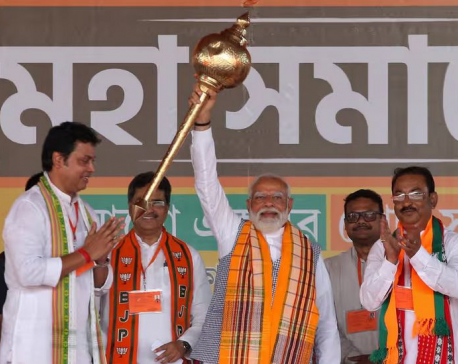
OR
Electronic Voting Machines
Sooner or later, Nepal had to adopt the Electronic Voting Machines (EVMs) that is gaining in popularity all over the world. But is the country ready for it right now? The Election Commission has reportedly started the process of purchase of EVMs from an Indian company for the upcoming provincial and federal elections that must be held by the constitutionally-mandated January 21, 2018 deadline. The commission is going electronic as the ballot-paper based voting has become needlessly “complex and costly”. The commission has asked its secretariat to present a final report, within a week, on the feasibility of using these machines for the upcoming elections. After this, a team will be sent to India to see if the Indian machines meet the commission’s requirements. If they do meet these requirements, it should not take long for the commission to buy and import them. There is in fact strong rationale for the use of EVMs. The first two phases of local elections, marred by inordinate delays and disputes over vote counting, showed just how inefficient our ballot paper-based voting system has become. Were there voting machines instead of ballot boxes, the election results would have been instant. The results would also have been more credible.
But would they? The previous attempt, in 2013, to import EVMs from India failed since these machines were at the time capable of accommodating the electoral symbols of only 64 parties, even as 122 parties were already registered with the commission. But the new machines can reportedly accommodate up to 128 political parties, which make them just about perfect for Nepal. Moreover, since the new electoral laws impose a vote threshold on the designation of political parties as ‘national parties’, there has been a wave of consolidation, most notably among the six small Madhes-based parties to form the Rastriya Janata Party Nepal. This wave of mergers could accelerate as the country enters the phase of provincial and federal elections, which means we could do with far fewer slots than are available in the new EVMs. So technically, there should not be much of a problem. But with under seven months to go to the January 2018 constitutional deadline, is there enough time for the kind of massive voter awareness campaign and for the as crucial buy-in of all our important political actors that introduction of EVMs will entail?
For the previous attempts to import these machines failed not just because of technicalities. In fact, many of our political parties were skeptical that EVMs could be used impartially. CPN-UML wanted to use EVMs to elect party officials during its last general convention. But the party decided against it when one of the contending factions said it could not be sure that the machines were not tampered with to suit the rival faction. So the buy-in of our political parties might not be easy to secure. The electorate could also be confused with the novel contraptions if they are not properly educated on the use of these machines. Even if they can somehow vote via these machines, can they be convinced about the sanctity of their votes? That said, we are all for using technology to make our voting process quicker and more reliable. Our concern is over the feasibility of adopting EVMs in such a short time. If the commission can make a convincing case, both before prospective voters as well as among our important political actors, it’s a thumbs-up from us.
You May Like This

Fixing a win by outlawing dissent damages democracy
The world’s largest elections begin this weekend in India, amid claims that the race to lead the country has already... Read More...

Rain shocks: On the monsoon in 2024
The India Meteorological Department (IMD) has forecast a bountiful monsoon. Rainfall from June-September is expected to be 6% more than... Read More...

Nagdhunga-Sisnekhola tunnel breakthrough: Beginning of a new era in Nepal’s development endeavors
The breakthrough of the Nagdhunga-Sisnekhola tunnel marks a significant leap forward in Nepal's development. For Nepalis who have only traveled... Read More...

Just In
- Over 200,000 devotees throng Maha Kumbha Mela at Barahakshetra
- Indians vote in the first phase of the world’s largest election as Modi seeks a third term
- Kushal Dixit selected for London Marathon
- Nepal faces Hong Kong today for ACC Emerging Teams Asia Cup
- 286 new industries registered in Nepal in first nine months of current FY, attracting Rs 165 billion investment
- UML's National Convention Representatives Council meeting today
- Gandaki Province CM assigns ministerial portfolios to Hari Bahadur Chuman and Deepak Manange
- 352 climbers obtain permits to ascend Mount Everest this season






_20220508065243.jpg)











Leave A Comment